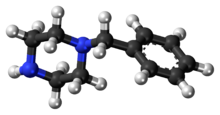Benzylpiperazine
 |
|
 |
|
| Clinical data | |
|---|---|
| Routes of administration |
Oral, intravenous, insufflation |
| ATC code | none |
| Legal status | |
| Legal status |
|
| Pharmacokinetic data | |
| Bioavailability | Unknown |
| Metabolism | Hepatic |
| Biological half-life | 5.5 Hours |
| Excretion | Renal |
| Identifiers | |
|
|
| CAS Number |
2759-28-6 |
| PubChem (CID) | 75994 |
| ChemSpider |
68493 |
| UNII |
3UG152ZU0E |
| ChEBI |
CHEBI:83537 |
| ChEMBL |
CHEMBL113600 |
| ECHA InfoCard | 100.018.567 |
| Chemical and physical data | |
| Formula | C11H16N2 |
| Molar mass | 176.258 g/mol |
| 3D model (Jmol) | Interactive image |
|
|
|
|
|
|
|
Benzylpiperazine (BZP) is a recreational drug with euphoriant and stimulant properties. The effects produced by BZP are comparable to those produced by amphetamine. Adverse effects have been reported following its use including acute psychosis, renal toxicity and seizures. No deaths have been reported following a sole ingestion of BZP, although there have been at least two deaths from the combination of BZP and MDMA. Its sale is banned in several countries, including Australia, Canada, New Zealand, the United States, the Republic of Ireland, the United Kingdom, Bulgaria, Romania and other parts of Europe.
It is often claimed that BZP was originally synthesized as a potential antihelminthic (anti-parasitic) agent for use in farm animals. However, there are some references to BZP in medical literature that predate interest in piperazines as antihelminthics. Even so, the majority of the early work with the piperazines were investigations into their potential use as antihelminthics with the earliest clinical trials in the literature relating to piperazine being articles in the British Medical Journal in the 1950s. It was discovered that BZP had side effects and was largely abandoned as a worm treatment. It next appears in the literature in the 1970s when it was investigated as a potential antidepressant medication, but rejected when research reported that BZP had amphetamine-like effects and was liable to abuse. The study suggested that BZP “should be placed under statutory control similar to those regulating the use of amphetamine.”
In the early 1990s, the United States Drug Enforcement Administration noted the drug was being used recreationally in California. It also reported that BZP was being used as an adulterant in illicit drugs. Not long after, there was an explosion in the drug's use worldwide – a situation which was soon followed by legislative control in many countries. Since 1999, benzylpiperazine use grew sharply in New Zealand due to an initial complete lack of regulation. The New Zealand government attempted to ban the product as of 18 December 2007, but the necessary second reading of the bill did not happen in time for the law to be passed. It was so widely used that an estimated 5 million pills were sold in New Zealand in 2007. Piperazine-based stimulants began to appear in Europe in 2000 but remained virtually unavailable in the rest of the world until recently. In early 2006, pills containing the active ingredients BZP and TFMPP began to appear in the city of Vancouver, British Columbia, Canada, where they first gained popularity with late night party-goers as a safer alternative to many of the illicit street drugs commonly available there. In 2007 piperazine based party-pill formulations started to become widely available nationwide which has caused concern with local authorities such as Health Canada and subsequently BZP has gained much media attention in 2008. As of May 2008 piperazines such as BZP and TFMPP have been under evaluation by Health Canada in order to determine whether or not party-pills pose a significant health risk to individuals. At this time no official decision has been made regarding these specific piperazines becoming restricted substances, or if they should be banned altogether in Canada. In the United States, it is still used as an adulterant in ecstasy mimic tablets.
...
Wikipedia
